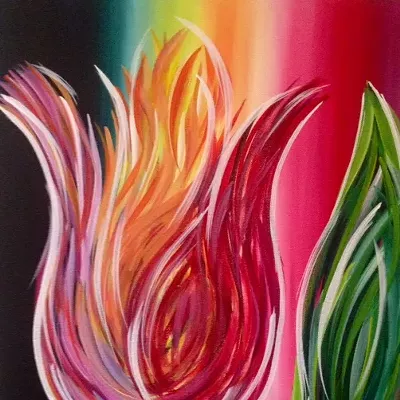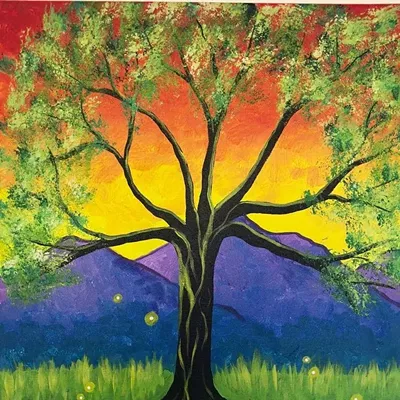Instead, what emerges from the 4-foot-square canvas are dozens of cheery white shapes--sloping triangles and bowties--dancing across the blue paint. They twinkle like stars on a twilit sky.
But look long enough, and the canvas undergoes a transformation. The blue passages turn into big blue circles of all sizes. The merry whites withdraw and turn into negative space, plain interstices between the blue figures.
The same thing happens with the gigantic triptych "Fireflies," painted in 1970, two years after "Blue Coins." Yellow triangles dart across a sky of midnight blue. The painting seems to be simply a happy abstraction of summer skies over Kentucky, where the German-born painter was living at the time.
It's only after a long look that the seemingly random "fireflies" began to transmit patterns from your eyes to your brain. You begin to see that these yellow triangles, like the white bowties, are arranged around big blue circles.
These two paintings are part of Wilke's Interstices series, which earned the modernist painter a considerable reputation during the 1960s, says gallery owner Lauren Rabb. The earliest works in the series were shown in a New York gallery in 1965; one of the paintings was included in the Art Across America exhibition that traveled in the U.S. in 1967; three others were in the Tokyo Biennial that same year.
Thomas Merton, the noted author and Trappist monk, living in the monastery at Gethsemane, Ky., praised the spiritual quality of the paintings' light.
"In the Hermitage, when the bright lamp burns on the table in the front room, I get patterns on the wall of the back room exactly like your latest pictures, with the light coming through the lattice work," he wrote to his friend Wilke in 1964. "Thus by miracle I have your pictures from time to time, on and off."
But by the time he painted Interstices, Wilke had already made a name for himself as a painter of inventive calligraphic abstractions. One of these paintings made it into a 1964 Museum of Modern Art exhibition of works based on lettering, Rabb says; she believes it was "Celeste," a 1964 acrylic on canvas, one of a dozen large canvases in her show, which she's called Master of the Line.
"Celeste" is inspired by a child's school chart, magnified perhaps 100 times. Childlike letters and blobs of color are arrayed on a giant pale gray grid, but nothing stays between the lines. The paint--in bright yellows, roses, blues, blacks--escapes from the squares with the glee of a child running from school at the end of the day.
Once celebrated, these cheerful paintings have been in storage at least since 1987, when Wilke died in Hawaii at the age of 80. Last year, when Rabb opened her gallery, with a focus on American mid-century modernism, a mutual friend put her in touch with Wilke's son Chris, a semiretired real estate developer in Tucson. Chris and his brother and sister "hadn't been doing anything with the estate," Rabb says.
The Wilkes agreed that Rabb should represent their dad's work, and the gallerist had the paintings restretched and reframed, and some of them restored. Rabb says she's actively trying to get a museum show for Master of the Line, which also includes 16 much smaller works on paper.
Chris Wilke, dropping coincidentally by the gallery the same day I did, explained that his father was born in 1907 in Bavaria, the son and grandson of artists. His mother was a painter and his father a well-known political caricaturist. His father died when Ulfert was a child, but he followed in his footsteps enough to arouse the ire of the Nazis by the late 1930s with his own political work.
"If you weren't the right kind of artist, it was not good," Chris Wilke says, and Ulfert Wilke fled in 1938. He had studied art in Germany and in Paris, and after coming to the United States, studied briefly at Harvard and served in the U.S. military, before beginning a long career as an art professor and museum director at universities around the United States.
"As an artist with three kids, he had to have jobs," Chris Wilke says.
But he painted during late afternoons, weekends and summers, and year-round during numerous sabbaticals and years abroad, in Japan and Europe, on Guggenheim Fellowships. Wilke brought his pleasure in pattern and color into everything he did, his son says, deliberately wearing socks in mismatching colors, and making random designs in the grass at their Iowa farm: "He'd go out and drive around on the lawnmower and ride in all directions."
Wilke was an inveterate letter writer, rising every morning at 7 to write five to 10 letters by hand, before beginning to paint around 10. Written in "cursive script with a blunt-pointed fountain pen," the art critic Gerald Nordland noted in a 1970 catalog essay, "his letter writing must be seen as an important influence on his response to any fresh sheet of paper, or newly stretched canvas."
And, in fact, his earliest calligraphic works were drawings located at just one degree of separation from the letters to friends. He made ink marks on paper, tiny lines and curves and slashes, drawing them over and over until they began to accumulate and create a larger shape. Called the Music to Be Seen series (nicknamed the 100 Hours series for the length of time they took to make), they're inspired both by music and language, and the principle of automatic or unconscious writing.
"Keep on drawing with these marvelous penpoints!" Wilke wrote with delight in his journal in 1956. "Repetitious, eclectic ... I just like the pen to make its marks. ... Just forget about anything: Use up all the paper and do one after another."
One of the Music drawings is in the show--it has a burst of lines in a vaguely cloudlike shape--and so are many paintings in which Wilke took his calligraphy to the big time. "Diervilla," 1967, 5 feet by 5 1/2 feet, is a musical mélange of white lines and squiggles against rich black. "Perfection," 1970, 5 feet by 5 feet, blows up the imaginary letters to almost the size of the canvas. Some are black, but the rest are in jazzy tones of green, orange and yellow.
Toward the end of his life, Wilke reverted to small-scale works on paper. The Viking Ship series from the 1980s is a charming set of collages inspired by a visit of reproduced Viking ships. In the 1981 "Viking Ship With Colorful Pennants," a rapid ink drawing conjures the sensuous curve of the hull, and cut-up pieces of water-colored paper evoke the festive sails.
His last series, Descent, 1986, is an unabashedly joyous meditation on life and its end. The three examples in the show all picture bright human figures in black death masks tumbling downward. But their bodies are entangled with each other, arms and legs intertwined, and they're colored happy pinks and purples. This is a death more fun than fearsome.
"My father was always in a good mood," Chris Wilke says. "He enjoyed things so much."














